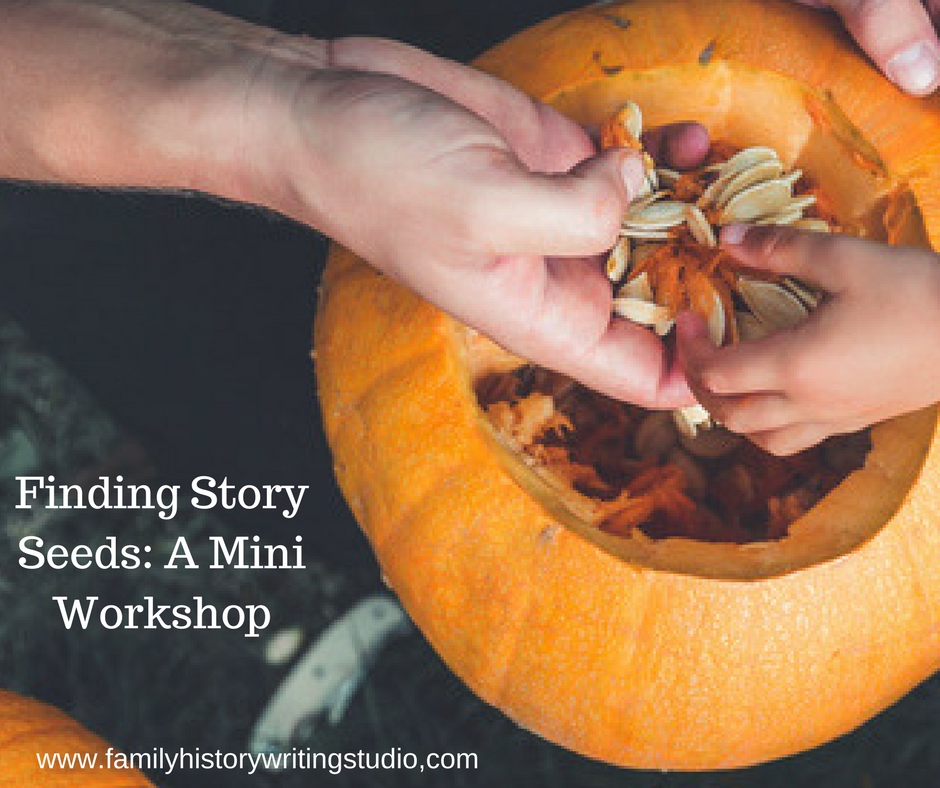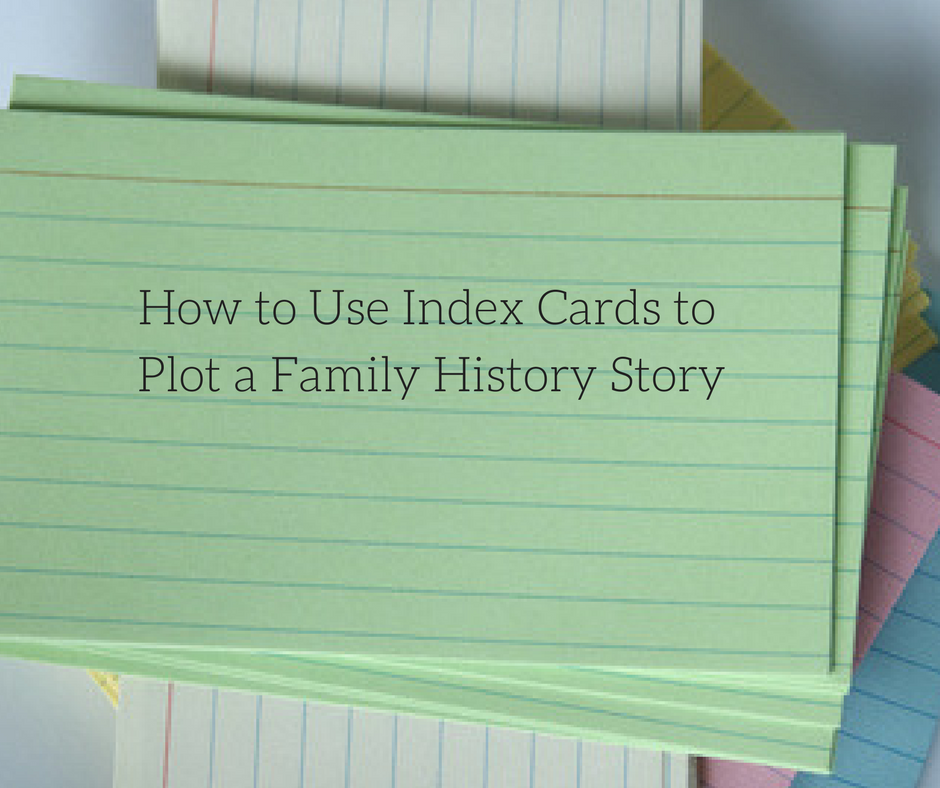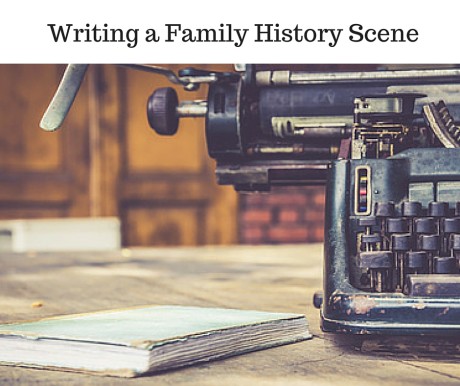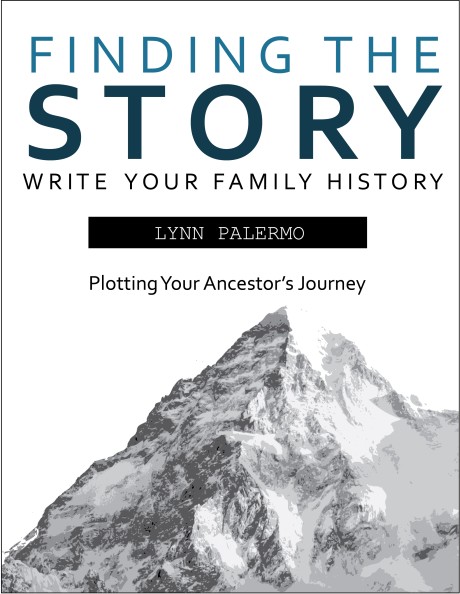Related Post

Finding Story Seeds: A Mini-WorkshopFinding Story Seeds: A Mini-Workshop
All too often when we think about writing our family history stories, we contemplate writing about those big story ideas. We want to write an ancestor’s life story from birth to death. We think about writing our family history from as far back as we have researched to present day. These are pumpkins. Gigantic pumpkins.
Your family history might very well be an inspiring and insightful story. But when writing your family history, you don’t always have to go big. Sometimes there are little seeds of stories buried within your research. I love those stories because they zoom in and show our ancestors in their most personal moments. These intimate moments will resonate with your readers.
Often, we have these pumpkin size ideas. Pumpkin ideas are cumbersome and hard to carry. They tend to wear us down. They are overwhelming. When you write about huge topics, you can tire out and lose interest. Huge topics can also be challenging to write, with so many aspects to consider. It’s more fun to dig out the seeds than carrying around a big awkward pumpkin.
LET’S CARVE UP OUR PUMPKIN IDEA AND FIND THE SEEDS
For example, my mother’s life story is a pumpkin size idea. It’s a huge pumpkin with over 85 years of life to write about. Even if I break her life story down into subtopics, they can still be significant. Watch me do this with my mother. I jot down pumpkin-sized ideas in my notebook.
They might look something like this:
- Growing up in Northern Ontario
- Working on the Tobacco Farms in Southern Ontario
- Married life and raising children
In my notebook, I have carved up my pumpkin and listed all sorts of things that were interesting about my mother’s life, as you can see above.
Now that I’ve carved up my pumpkin, I begin to see the seeds and start to pull out those seeds.
- Her first job cooking and cleaning for a family
- The day she left home
- Blueberry picking trips
- Giving her baby sister her first bath
- Cooking meals at the Poorhouse
Ohhhh, see that!? Now, these moments are starting to sound more like stories, and less like topics. You saw how I did that, right? Finding my seed ideas inside that big pumpkin of a life story.
Now, you may already have ideas that are somewhat specific. Maybe you’ve carved your pumpkin already instead of leaving it whole. But I challenge you to zoom in and pull out those small seeds.
NOW IT’S YOUR TURN TO FIND SEED IDEAS
Grab your writing notebook, and identify an ancestor you want to write about. This is your pumpkin idea.
Next, create subtopics, carve up that pumpkin, usually around time periods or significant events in your ancestor’s life. They may look like this:
- marriage
- immigration
- buying land
- going to school
- career
Next, take that carved pumpkin and pull out the seeds, those little ideas within those topics.
For example,
Immigration
- Buying the ticket
- Seeing North America from the ship for the first time.
Job
- First day on the job
- Receiving an award
- Last day on the job
Marriage
- A funny event at the ceremony.
- First date
- Marriage proposal
Seed ideas are usually memorable moments in a person’s life, but they also can trigger random specific moments in their life that can hold significant meaning.
If you’ve been struggling to get your family history stories out, I’d suggest it could be that you’re carrying too large of an idea. Every time you write, remember to zoom into your ideas, carve up the pumpkin and start to pull out those small seeds. A seed idea is quite fun and manageable to write about!
Go on, dig out those seeds and start writing.

How to Use Index Cards to Plot a Family HistoryHow to Use Index Cards to Plot a Family History
I’m known as a plotter. This means I love to outline my stories in great detail before I begin to write. For me, it’s like creating a road map of a story from start to finish. It allows me to organize my story so that when I start to write I know exactly what I’m writing and where I’m going with the story. It eliminates sitting and staring at my computer screen in that deep dark hole known as writer’s block.
I use index cards to create this map. Each index card represents a scene or a summary. A creative nonfiction story is comprised of scenes and summaries and having those scenes carefully thought out in advance can help keep you organized and writing every day. Check out my scene building cards that I designed just for family history writers.
Once I have my story mapped out with my index cards, then I can begin to write my first draft.
While index cards may seem a rather old-fashioned method for outlining it is with good reason it’s still around, it works. Of course, just as technology has impressed itself on every aspect of our lives even the little old index card has not gone untouched by the digital world. You can still use paper index cards if you are tactile, and like the physical feel of a paper card in front of you. I love to lay out my index cards on a corkboard in my office it keeps my story in front of me and top of mind.
There are plenty of digital index cards available today that have replaced the paper card. For instance, Scrivener offers index cards on a corkboard so that you can storyboard your family history within the writing program. Check out this video to see how to use the Scrivener corkboard. Scrivener also offers the ability to print off those cards so you can still have those paper cards to shuffle around on a physical corkboard.
There are plenty of apps for index cards, the Corkboard Writing app, and the Index Card app are just a couple. Most are available for iPads and iPhones. Check the Apple App store for a selection.
Elements of an Index Card
An index card will record either a scene or a summary on the card. On each card, you will record bullet points to help you write that particular scene or summary. Here is an article that explains the difference between scene and summary.
Scene cards should contain a few basic elements that will help you to write the scene when it comes time to put pen to paper.
Who – the primary ancestor in the scene
Scene Goal – your ancestor hopes to accomplish an explicit goal with the scene. Read here about scene goals.
Action – what physically happens in the scene.
Setting – Where and when does it happen? Indoors? Outdoors? Time of year, day, place, etc.
Conflict – within the scene is conflict, tension or suspense.
Inner Journey– how is your ancestor emotionally affected by the outer journey or action happening in the scene.
Theme – Do the details in the scene support the theme you have created?
Index cards are another tool in our writer’s toolbox that helps us to break down our writing into manageable tasks, keeping us from becoming overwhelmed and hitting that all too familiar writer’s block.

Want to learn more about how to write to write a family history scene consider our upcoming class, Writing a Family History Scene.
To understand how to format a story using scene cards, consider joining us for our upcoming course Plotting a Family History Story or our e-workbook, Finding the Story. Also available on Amazon in paperback.

